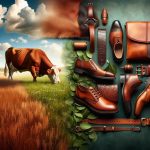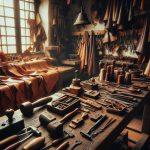Leather's basically a durable material made from tanning animal hides. It's tough and can come from various animals like cows, pigs, goats, and even more exotic ones like alligators. Each type gives different qualities to the leather, making it unique. Folks use it mostly for things like shoes, jackets, and bags because it lasts long and looks great. It's also got different grades, from full grain, which is top-notch, to split leather. Plus, there's a whole art to caring for it to keep it in good shape. Stick around, and I'll tell you how to spot the good stuff and make it last.
Table of Contents
Key Takeaways
- Leather is a durable material made from tanned animal hides.
- It is commonly sourced from cattle, sheep, goats, and exotic animals like alligators.
- Leather is used in various products, including clothing, accessories, and furniture.
- Tanning methods like vegetable and chrome tanning enhance leather's durability and appearance.
- Leather grades, such as full grain and top grain, indicate the quality and treatment of the material.
Origins and History
Leather tanning, an age-old craft, has been shaping human history for thousands of years. It's not just a method; it's a transformative process that turned simple animal hides into durable leather, essential for survival and development. Let me take you back to how it all began.
In the early days, our ancestors quickly figured out they needed more than just raw hides. They needed something that would last. Enter early tanning methods. They experimented with rubbing animal fats and smoking hides, but the real game-changer was vegetable tanning. This method, using tannins extracted from tree bark, was a breakthrough. It wasn't just about making leather; it was about making it durable, resilient.
Ancient civilizations like Egypt, Rome, and Greece took these basic ideas and ran with them. They refined the tanning techniques and turned leather crafting into an art. Imagine the meticulous work of turning tough hides into soft, pliable materials. That's the kind of mastery and innovation that propelled societies forward.
Types of Leather
Now, let's talk about the different types of leather and how they're made.
We'll look at where leather comes from and the various methods used to process it.
Understanding these points helps us appreciate the quality and craftsmanship behind each piece of leather.
Leather Source Varieties
Throughout history, various animals like cattle, sheep, goats, pigs, and horses have provided us with different types of leather. Each type has its own unique characteristics, which are influenced by the animal sources, tanning methods, and finishing techniques. This variation affects the leather quality significantly.
Here's a quick look at how these factors play out:
| Animal Source | Unique Characteristics | Common Uses |
|---|---|---|
| Cattle | Durable, versatile | Belts, shoes |
| Sheep | Soft, flexible | Jackets, gloves |
| Goats | Tough, water-resistant | Bags, wallets |
| Pigs | Breathable, economical | Clothing, upholstery |
Understanding these details helps you choose the right type of leather for your specific needs.
Leather Processing Methods
Exploring how leather is processed reveals a fascinating array of techniques that shape its final form and function. First off, you've got vegetable-tanned leather. It's all about using natural materials like tree bark. It's a traditional tanning method, loved for its eco-friendliness.
Then there's chrome-tanned leather, which is quicker and involves some serious chemicals, giving it a soft feel.
We also see different grades popping up through these methods. Full-grain leather? That's the real deal, top quality, with the surface left untouched. Top-grain leather is slightly refined, still high quality but a bit more flexible. Each type of leather processing plays a huge role in how our final leather products look, feel, and last.
Tanning Methods
Let's look at how leather tanning has evolved.
We'll start with traditional techniques like using tree bark and animal brains, and then move on to modern methods that use chemicals for faster results.
It's fascinating to see how innovations have changed the game, but also what environmental issues they bring.
Traditional Tanning Techniques
How did people traditionally turn animal hides into leather? They relied on several traditional tanning techniques, each with its unique approach and results. Here's a quick rundown:
- Vegetable tanning: This method used natural tannins from tree bark to create durable, water-resistant leather. It was a slow process, often taking months.
- Chrome tanning: Introduced later, this used chromium salts to produce leather that was soft, supple, and brightly colored.
- Brain tanning: A Native American technique that used animal brains for tanning, making the leather exceptionally soft and pliable.
Each method had its special use, from rugged outdoor gear to fine clothing and accessories, showcasing the versatility and craftsmanship in traditional tanning techniques like alum leather and aldehyde tanning.
Modern Tanning Innovations
Today, modern tanning methods have revolutionized the way we produce leather, making the process faster and more eco-friendly. Take chrome-tanned leather, for example. It uses chromium salts for a quicker, more uniform result. It's a huge shift from the slower vegetable-tanned method, which relies on natural tannins and can take months.
These modern tanning methods aren't just about speed. They're also about being environmentally friendly. Innovations in chemical treatment and tanning processes help reduce waste and pollution. This is crucial as we aim for more sustainable practices in every industry, including leather production. So, whether it's chrome-tanned or vegetable-tanned, modern tanning is shaping up to be both efficient and kinder to our planet.
Leather Grades
Leather comes in various grades, including full grain, top grain, corrected grain, nubuck, and split leather. Each type has its unique characteristics and uses, making it essential to understand them, especially if you're keen on mastering leather quality.
Full grain leather is top-notch. It's the most durable and showcases the hide's natural markings, which many find incredibly attractive. It's excellent for products where longevity and patina are cherished.
Top grain leather, while still high quality, has some of the surface imperfections removed. This process makes it a bit more uniform in appearance than full grain but less durable. It's a common choice for high-end leather goods where a perfect finish is desired but full exposure isn't needed.
Corrected grain leather is altered further, having been sanded to remove more imperfections and embossed to create a consistent texture. It's less expensive and offers a more uniform look but lacks the natural authenticity of higher grades.
Nubuck provides a soft, velvety surface, created by lightly sanding the exterior of top grain leather.
Split leather, used mainly for suede, is more affordable but less durable.
Understanding these differences helps you choose the right leather for your needs, balancing cost, appearance, and durability.
Animal Sources
Let's talk about where leather comes from.
We usually get it from animals like cows and sheep, but there are also exotic sources.
Each type of animal gives the leather its own unique feel and strength.
Common Leather Animals
Many common leather products come from the skins of cattle, sheep, goats, pigs, and horses. These animals are crucial in leather production, each offering unique qualities to the leather they produce.
- Cattle:
Provide durable leather, often used for shoes and jackets.
- Sheep:
Known for soft, flexible leather, ideal for gloves and finer garments.
- Goats:
Offer a distinctive texture, making them popular for luxury accessories.
I've noticed that understanding these sources helps in identifying not just the quality but also the best use of each type of leather. It's fascinating how each animal contributes uniquely to the array of leather products we use daily.
Exotic Leather Sources
Beyond the usual sources, exotic animals like alligators and ostriches also contribute to the diverse world of leather. Crocodiles, snakes, and stingrays are also key exotic leather sources.
Alligator and crocodile skins are super valued for their tough yet distinct textures which make them perfect for luxury goods. They're not just tough; they're stylish, too. Snakeskin, with its cool scales, really stands out in fancy accessories. It's all about that unique look.
Ostrich leather is another gem. It's incredibly soft and flexible, plus it has those natural patterns that catch everyone's eye. And don't forget stingray leather—it's tough as nails and has a pebbled texture that looks amazing on high-end items. These exotic sources surely spice up the leather world!
Environmental Impact
The environmental impact of leather production is significant, stemming from both the chemical processes involved and the natural resources consumed. It's clear that the way we produce and dispose of leather needs serious reconsideration. Here's why:
- The tanning process, which transforms raw hides into leather, uses harsh chemicals that can harm our environment. This isn't just about the immediate area either; these chemicals can seep into waterways, affecting broader ecosystems.
- Leather waste disposal poses its own set of challenges. Since leather doesn't break down easily, it accumulates, contributing to landfill issues and long-term environmental damage.
- Animal rights and the deforestation linked to cattle grazing are also critical. The demand for leather contributes to these practices, which have a domino effect on wildlife habitats and carbon emissions.
Exploring sustainable practices is crucial. By supporting methods like vegetable tanning and responsible sourcing, we can mitigate some of these impacts. It's about making smarter choices in how we produce and treat leather goods, aiming for a balance that respects both our planet and its inhabitants. As consumers, we hold power in demanding better practices and opting for products that align with these values.
Leather Care
Caring for your leather items properly extends their life and keeps them looking great. Leather care starts with regular cleaning. I use a damp cloth to wipe off dirt and dust. This simple step avoids buildup and maintains the leather's look.
Next, I always apply a conditioner. Leather can dry out, and without conditioner, it might crack. Using a good leather conditioner keeps it supple and prevents damage. It's a bit like moisturizing your skin!
I also make sure to store my leather goods correctly. I keep them in a cool, dry place. Direct sunlight and heat can fade and harm the leather, so I avoid placing them near windows or in damp areas. Proper storage prevents unwanted wear and tear.
For tough stains or when I need a deep clean, I rely on professional cleaning. They have the right tools and expertise to handle sensitive leather, ensuring it doesn't get damaged in the process.
Lastly, I steer clear of extreme temperatures and humidity. This helps maintain the leather's quality and appearance over time. These steps ensure my leather stays in top shape, year after year.
Cultural Significance
Leather's role in various cultures is both profound and extensive. It weaves through our history as a traditional material, essential in fashion trends and daily life. As I've learned more about the leather industry, I've seen how it shapes and is shaped by society's norms and needs.
The cultural significance of leather is evident in several key areas:
- Fashion Trends: Leather sets the pace in fashion. From rugged jackets to sleek accessories, it's always in vogue, influencing styles worldwide.
- Religious Restrictions: In cultures with specific religious practices, like Judaism and Jainism, leather use is often restricted. This has led to careful labeling to ensure adherence to faith-based requirements.
- Traditional Material: For centuries, leather has been pivotal in crafting goods from shoes to saddles, showcasing its enduring appeal and functionality.
Despite its rich history, the leather industry isn't static; it adapts, exploring innovations like biodegradable materials to meet changing cultural demands. Understanding these dynamics helps me appreciate leather's place not just in markets, but in the very fabric of societies. It's more than a material; it's a testament to human ingenuity and cultural expression.
Leather Alternatives
Exploring alternatives to traditional leather, I've discovered options like artificial and lab-grown leather that cater to ethical and sustainable preferences. Let's dive deeper into these innovative choices.
First off, artificial leather really stands out due to its cost-effectiveness. It looks and feels a lot like real leather but doesn't use any animal products. This makes it a great pick for anyone looking to avoid animal cruelty without sacrificing style.
Then there's lab-grown leather. This stuff is science in action! Created in labs using animal cells, it offers a cruelty-free alternative that still comes from real leather's biological building blocks. It's perfect for those who are okay with using animal cells but want to avoid the harm traditional leather production causes.
Mushroom-based materials are another game-changer. Derived from mushrooms, these materials aren't just eco-friendly but also biodegradable. They represent a huge leap toward sustainability, breaking down naturally without leaving harmful residues.
Each of these options—artificial leather, lab-grown leather, and mushroom-based materials—provides a practical solution for those seeking ethical and sustainable alternatives. They're about making choices that align with our values without compromising on quality and utility.
Modern Uses
Leather is a key player in many industries, from fashion to furniture, due to its durability and sleek appearance. It's not just about looking good; leather's resilience makes it ideal for items that need to last. We're talking about everyday essentials and luxury pieces that you'll use for years.
Here's why leather remains a top choice:
- Footwear: Leather shoes and boots combine flexibility with durability, perfect for daily wear or special occasions. They mold to your feet, getting comfier with each use.
- Accessories: From belts to handbags, leather accessories add a touch of class and sophistication. They're not only stylish but also incredibly sturdy.
- Upholstery: Leather furniture and car interiors aren't just about luxury; they're practical, too. Leather withstands wear and tear better than many materials, maintaining its elegance over time.
Whether it's suiting up for a cold day with leather gloves or sitting back in a leather-upholstered luxury car seat, the material's durability and luxury feel play a big role. So, when I'm choosing a product that blends style with functionality, leather is often my go-to choice.
Frequently Asked Questions
What Is the Brief Description of Leather?
Leather's a tough material made from tanned animal hides. It's used in many products like shoes and jackets. It varies in quality and type, each offering different benefits like durability and style.
How Would You Describe Leather Texture?
Leather's texture varies widely; it can be smooth, grainy, or velvety like suede. Full grain leather shows natural imperfections, while top grain is smoother due to finishing treatments. Textured leather might feature embossed designs.
What Is the Appearance of Leather?
Leather's appearance can vary, showing natural marks like wrinkles and scars. It ranges in color and texture, often compared to fine wood, and high-quality examples have evenly dyed, soft yet durable surfaces.
What Is This Leather?
I'm not sure which type of leather you're referring to. It could be full grain, top grain, enhanced grain, corrected grain, or split leather. Each has different qualities and uses.
- The Luxury of Silk Crepe De Chine: Is It Worth the Investment? - June 23, 2025
- What Is Polyester Crepe? a Guide to This Versatile, Affordable Fabric - June 23, 2025
- 10 Types of Crepe Fabric You Need to Know (With Pictures) - June 23, 2025







